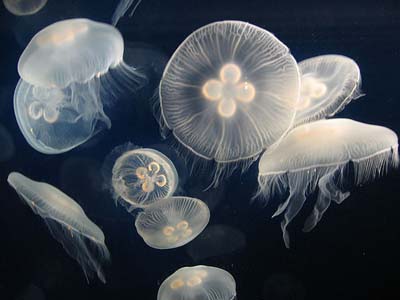Keep your eyes peeled for jellyfish
Unusual creatures, particularly jellyfish, are becoming more common in British waters, say scientists


The sunshine has brought all sorts of people flocking to Britain's beaches - and some unusual visitors to our seas, too. Jellyfish, generally a rare sight in the UK, have been spotted all around the coastline, drawn to the warmer waters.
Dr Peter Richardson, the Marine Conservation Society's biodiversity programme manager, is fascinated by recent developments, and believes that jellyfish numbers are ‘important indicators of the state of our seas'. ‘The scarcity of jellyfish reports before June was unusual, and could well be linked to the exceptionally cold spring,' he explains.

Moon Jellyfish are becoming more common in British waters
** Subscribe to Country Life; Country Life on Ipad
‘However, as our waters warmed, sightings of jellyfish increased, with moon jellyfish reported in large numbers around the UK, reports of compass and blue jellyfish in the South-West, and blooms of lion's mane jellies around North Wales and North-West England.' The Irish Sea has been described as a veritable ‘jellyfish soup', with several species present in large numbers.
Dr Richardson urges people to report any sightings in the sea or on the beach to the Marine Conservation Society by visiting www.mcsuk.org. However, he stresses the importance of keeping your distance from jellyfish - some species, such as the lion's mane jellyfish, have a serious sting.
* Follow Country Life magazine on Twitter
Exquisite houses, the beauty of Nature, and how to get the most from your life, straight to your inbox.
Image: www.jellyfishfacts.net
Emma Hughes lives in London and has spent the past 15 years writing for publications including the Guardian, the Telegraph, the Evening Standard, Waitrose Food, British Vogue and Condé Nast Traveller. Currently Country Life's Acting Assistant Features Editor and its London Life restaurant columnist, if she isn't tapping away at a keyboard she's probably taking something out of the oven (or eating it).
-
 This Suffolk home is a perfect escape from the world and it comes with its own stretch of river and 20 acres
This Suffolk home is a perfect escape from the world and it comes with its own stretch of river and 20 acresThis idyllic home in Suffolk is the perfect village home.
-
 We remember Prunella Scales in the Country Life Quiz of the Day, October 28, 2025
We remember Prunella Scales in the Country Life Quiz of the Day, October 28, 2025The actor passed away today and is best known for her role opposite John Cleese in the TV programme 'Fawlty Towers'.
